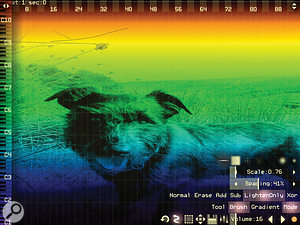Virtual ANS is a software simulation of a remarkable Russian synthesizer created by engineer Evgeny Murzin over a 20-year period from the late 1930s. The synth was named to honour Russian composer Alexander Nikolayevich Scriabin and there's only one in existence, but if you've ever seen the Russian sci-fi movie Solaris, you may already be familiar with its weird and other-worldly tones.
 ANS has enough graphical tools to design a wide variety of shapes and, therefore, sonic textures.This is not a conventional iPad synthesizer. True, it can be played from a keyboard, but its real strength is in generating some of the most atmospheric drones and spooky shifting textures you'll encounter sans hallucinogenics. It's also available for Windows, Linux, OS X and Android, but the interface is perfectly suited to a tablet and performance was fine on my iPad 2.
ANS has enough graphical tools to design a wide variety of shapes and, therefore, sonic textures.This is not a conventional iPad synthesizer. True, it can be played from a keyboard, but its real strength is in generating some of the most atmospheric drones and spooky shifting textures you'll encounter sans hallucinogenics. It's also available for Windows, Linux, OS X and Android, but the interface is perfectly suited to a tablet and performance was fine on my iPad 2.
It turns the idea of representing a sound graphically on its head. Sound is synthesized from a drawn 'sonogram' scanned forwards or backwards, or from an audio recording or an imported image or Wav. In the original machine a glass plate covered in black mastic was scratched to create images. Virtual ANS goes way beyond mere scratchings, utilising an array of tools comparable to those of a graphical photo editor. And where the original generated up to 720 simultaneous microtones spread over 10 octaves, Virtual ANS easily exceeds this number. The only limits are those imposed by your hardware.
 It's easy to get carried away with this importing lark.When creating a new project, it's vital to set an image resolution your machine can handle. The more pixels you draft in, the more likely it is that lowly iPads will struggle. Fortunately there are tips online, including a suggestion of a 'normal' number of pixels and ideal sampling rate for an iPad 1. This is especially relevant when importing existing images via the Wi-Fi Export/Import option (or iTunes). Imported audio, when rendered, is often almost unrecognisable, which is a major part of its charm.
It's easy to get carried away with this importing lark.When creating a new project, it's vital to set an image resolution your machine can handle. The more pixels you draft in, the more likely it is that lowly iPads will struggle. Fortunately there are tips online, including a suggestion of a 'normal' number of pixels and ideal sampling rate for an iPad 1. This is especially relevant when importing existing images via the Wi-Fi Export/Import option (or iTunes). Imported audio, when rendered, is often almost unrecognisable, which is a major part of its charm.
Budding artists will quickly realise that the brush shape defines the way tones are painted and therefore heard. The scrolling tone generator can produce dense clusters of harmonics and cones of fuzzy microtones alongside sharper, brighter lines that cut through sonically. With a few swirls of my finger I was reminded of the alien harmonic textures created by another rare and wonderful instrument, the Dewantron Swarmatron. If you start with a blank canvas and draw a single vertical line across the 10-octave keyboard, every tone will play simultaneously at that point.
 Touching either transport key results in ANS playing forwards or backwards and I was pleased to learn variable loop points and ping-pong looping are under consideration for the future. If you touch the beat markers at the top of the interface, playback leaps directly to that point. Similarly, you can play the on-screen keyboard with a finger or plug in a MIDI keyboard via the camera kit. I experienced occasional hanging notes doing this but not enough to put me off building up ethereal musical loops.
Touching either transport key results in ANS playing forwards or backwards and I was pleased to learn variable loop points and ping-pong looping are under consideration for the future. If you touch the beat markers at the top of the interface, playback leaps directly to that point. Similarly, you can play the on-screen keyboard with a finger or plug in a MIDI keyboard via the camera kit. I experienced occasional hanging notes doing this but not enough to put me off building up ethereal musical loops.
I especially enjoyed recording into the timeline from the iPad's own input. My utterings were quickly converted to an image and re-synthesized ready for playback. Playback speed is adjustable post recording and several effects are on tap too, including reverb and various types of contrast adjustment or blurring. It's not quite Photoshop, but the effects typically add shimmering harmonics around any selection, rapidly transforming your project into an immersive sonic swamp. Comparisons could also be made with iZotope's Iris, except that here no single waveform is synthesized for you to play. Instead, a complete tonal landscape is formed through which you travel. Hopefully this introduction will be enough to whet your appetite. Personally, I don't see Virtual ANS joining the list of iPad synths I update more than I actually use. Highly recommended.
£3.99.
$5.99.
